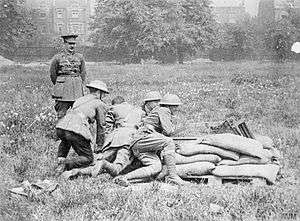West Spring Gun
| West Spring Gun | |
|---|---|
 | |
| Type | Catapult |
| Place of origin | United Kingdom |
| Service history | |
| In service | 1915–1916 |
| Used by |
United Kingdom Canada Australia |
| Wars | World War I |
| Production history | |
| Designer | Captain Allen West |
| Designed | 1915 |
| Manufacturer | Reason Manufacturing Company |
| Produced | 1915-1916 |
| Specifications | |
| Weight | 284 lb (129 kg) |
| Length | 71.5 in (182 cm) |
| Width | 18.5 in (47 cm) |
| Height | 88 in (220 cm) |
| Crew | 5 |
|
| |
| Effective firing range | 240 yd (220 m) |
The West Spring Gun was a bomb-throwing catapult used by British, Canadian and Australian forces during World War I. It was designed to throw a hand grenade in a high trajectory into enemy trenches.
Description
It consisted of a metal frame supporting a throwing arm powered by 24 metal springs.[1] It was invented by Captain Allen West in 1915 and manufactured by the Reason Manufacturing Company of Brighton, which was granted a patent for the device on 19 October of that year.[1][2] Although called a catapult, it was a hybrid of a ballista and a trebuchet. It required a crew of five - three to compress the springs, one to load the bomb, and one to fire as soon as the fuse was lit or the grenade pin was pulled.[3]
In tests, it could throw Mills bomb about 240 yd (220 m) or a 7 lb (3.2 kg) projectile about 80 yd (73 m) with a flight time of 6 or 7 seconds.[4] In the field it generally threw a Jam Tin Grenade, No. 15 Ball grenade, No. 21 "Spherical" grenade or No. 28 chemical grenade, equipped with a slightly longer fuse (typically 9 seconds) to ensure to reach the enemy trench before exploding.[2] It was used in combat by, amongst others, the 50th (Northumbrian) Division and the 1st Canadian Division in the Second Battle of Ypres and by Australian forces in the Gallipoli Campaign.[2][5] It was generally considered to be large and cumbersome and "generally more unwieldy" than the Leach Trench Catapult.[4] Many operators, including Captain West himself, lost fingers in the mechanism.[1] The throw could also be unpredictable, with the bomb sometimes landing near the thrower.[6]
Production of this and other trench catapults was officially halted in 1916, being replaced by the 2 inch Medium Trench Mortar and Stokes mortar.[7]
Ammunition
 No 21 R grenade
No 21 R grenade
References
- 1 2 3 Gary Sheffield (2007). War on the Western Front: In the Trenches of World War I. Osprey Publishing. p. 201. ISBN 1846032105.
- 1 2 3 Anthony Saunders (1999). Weapons of the Trench War: 1914-1918. Sutton. p. 65. ISBN 0750918187.
- ↑ Clifford Almon Wells (1917). From Montreal to Vimy Ridge and beyond: the correspondence of Lieut. Clifford Almon Wells, B.A., of the 8th battalion, Canadians, B.e.f., November, 1915-April, 1917. George H. Doran company. p. 87.
- 1 2 The Royal Engineers Journal. The Institution of Royal Engineers. 39: 79. 1925. Missing or empty
|title=(help) - ↑ Kenneth Radley (2006). We lead, others follow: First Canadian Division, 1914-1918. Vanwell. p. 120. ISBN 1551251000.
- ↑ "Grenade, West Spring Gun, No 21 R Type". Imperial War Museum.
- ↑ Hugh Chisholm (1922). The Encyclopædia Britannica: The New Volumes, Constituting, in Combination with the Twenty-nine Volumes of the Eleventh Edition, the Twelfth Edition of that Work, and Also Supplying a New, Distinctive, and Independent Library of Reference Dealing with Events and Developments of the Period 1910 to 1921 Inclusive, Volume 1. Encyclopædia Britannica Company Limited. p. 470.
External links
- No 21 R Type grenade for the West Spring Gun at the Imperial War Museum.
- West Spring Gun (missing its launch arm) at the Australian War Memorial.